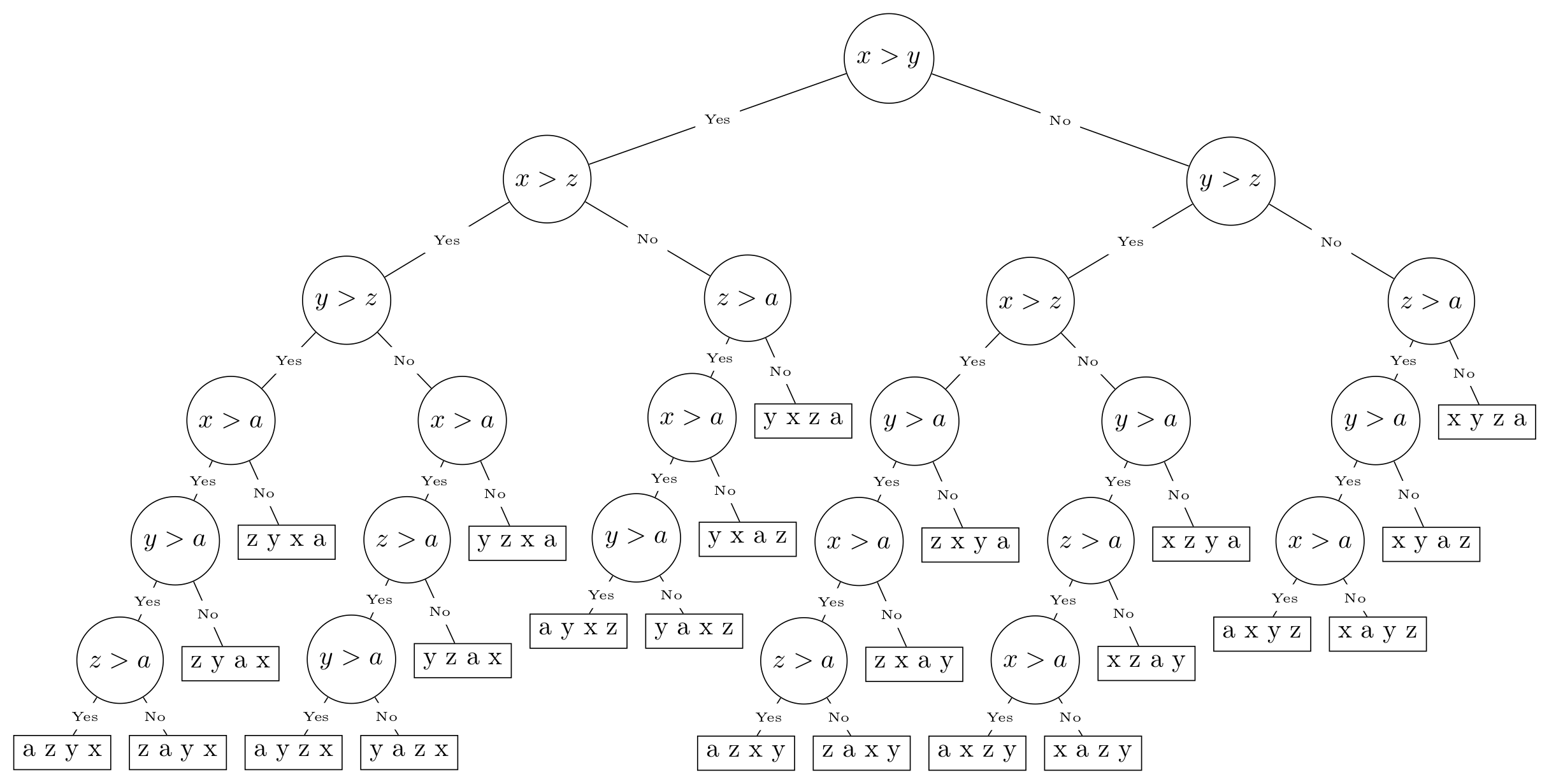Program for generating decision tree LaTeX code for array-based algorithms
Project description
Program for generating decision tree LaTeX code for array-based algorithms

Insertion Sort Decision Tree
Overview
This project began with the idea of being able to generate a pruned, valid decision tree for any simple algorithm that performs operations on a small list of data. Above is an example of such a tree for the Insertion Sort algorithm with the list of elements ['x', 'y', 'z', 'a'].
Usage
When run on a particular algorithm, the program generates complete Latex code to form a pruned, valid decision tree for that algorithm.
The main package provides a class TreeGenerator, which should be inherited with the algorithm() method overrided. In that method, an algorithm should be entered that performs operations on the self.data list. Whenever a comparison of records is to be made in your algorithm, substitute the comparison with the following method call:
self.comp(<first record (self.data[x])>, <comparison operator ('<')>, <second record (self.data[y])>)This method will return boolean values to control how the algorithm operates.
To generate the decision tree, follow these steps: * Create an instance of your algorithm’s class. * Run the execute() method on this object. * Run the render() method and save/print the outputted Latex code.
From there, the Latex code can be placed into a .tex file and compiled using a Latex processor.
Example
Example algorithms and usage can be found in src/example.py.
How it Works
The main execute() method starts by initially calling the algorithm implementation. Whenever a comparison is made, the program saves a “state” of the program execution and adds a node to a tree structure for printing the Latex code. It then returns True to cause the program to make a left branch. With each comparison made, it checks to verify the last comparison is valid and prunes the node if not. If the comparison is not valid, it puts the algorithm in “lame duck” mode, which instructs the comparison method to always return False, letting the algorithm run out its course. It continues this process until the algorithm exits.
Once the algorithm exits, the program figures out what boolean values the comp() function must return in order to restore the execution state to the latest left (True) branch in the algorithm. It then makes a right branch and continues the process all over again.
In this way, it explores all possible valid paths the algorithm could take, given the input data and generates a tree structure to represent it. From there, the render() method performs a pre-order traversal of that tree, generating the Latex code as it goes.
Contribution
If you have an addition you would like to make or find an issue, please either open an issue or submit a pull request and I’ll try to handle it as soon as possible.
Project details
Release history Release notifications | RSS feed
Download files
Download the file for your platform. If you're not sure which to choose, learn more about installing packages.
Source Distribution
File details
Details for the file Decision-Tree-Generator-0.0.4.tar.gz.
File metadata
- Download URL: Decision-Tree-Generator-0.0.4.tar.gz
- Upload date:
- Size: 7.4 kB
- Tags: Source
- Uploaded using Trusted Publishing? No
- Uploaded via: twine/1.12.1 pkginfo/1.5.0.1 requests/2.21.0 setuptools/39.2.0 requests-toolbelt/0.8.0 tqdm/4.29.1 CPython/3.7.0
File hashes
| Algorithm | Hash digest | |
|---|---|---|
| SHA256 |
2f693f406b7bc9eed7a8842e86d661aa4ad42bbd04b0f78d7a0d8fb70f63df5b
|
|
| MD5 |
63be4a16d8009c47a43bae0438277cfe
|
|
| BLAKE2b-256 |
7b0504815cee47bc148c1d5c8e6d11983d4001953ca23574d11b9177d088031d
|










